The
Town of Newmarket is responsible for clearing all sidewalks in Newmarket as per O. Reg. 239/02: MINIMUM MAINTENANCE STANDARDS FOR MUNICIPAL HIGHWAYS (MMS 239/02) Learn
more about the Town's process and procedures for sidewalk snow clearing by
viewing the frequently asked questions below:
Who plows the sidewalks in Newmarket?
The Town of Newmarket aims to clear 100 per cent of sidewalks in Newmarket - specifically those that are greater than 1.0 m (40 inches) in size. Major routes with sidewalks 1.2 m or less in size, that have historically always been plowed (legacy sidewalks) will continue to be maintained by the Town as long as they are curb facing or are considered primary routes to businesses, schools and the hospital.
The Town will begin to plow primary sidewalk routes once there is more than 6 cm of snow. Clearing primary routes can take up to 24 hours to complete. Secondary routes will be completed once the primary routes are finished.
Subdivisions that are not assumed by the Town will not be cleared. Developers are required to clear sidewalks in un-assumed areas. Property owners are asked to clear the sidewalk adjacent to their property.
Please do not park over the sidewalk, it is a violation of the
Town's parking By-law 1993-62 and you may be subject to a fine.
Which sidewalks get cleared first in Newmarket?
The Town of Newmarket's sidewalk clearing routes are separated into primary routes and secondary routes. The Town clears primary routes first. Once primary routes are completed by the Town's crews and contractors, they will plow secondary routes. As per MMS 239/02
Primary routes are sidewalks on major roads such as Davis Drive, Yonge Street, Leslie Street, Mulock Drive and Bayview Street – and other routes that lead to major business areas, the hospital and schools. Secondary routes are usually those on residential streets.
When are sidewalks cleared?
Town staff continuously monitor weather conditions and our sidewalks to ensure they are safe for our community.
As part of the MMS 239/02, the Town is required to have winter sidewalk maintenance patrollers including nightly that monitor and document various locations throughout Newmarket. They capture conditions such as air and ground temperatures, depth of snow, surface conditions, forecasted weather etc. Night patrollers keep standby staff and supervisors updated to help determine when and if winter maintenance is needed.
Sidewalk winter maintenance generally begins at 5 a.m. Depending on weather conditions, sidewalks snow plows will be salting/sanding to ensure the safety of our community. Sidewalk snow plowing begins when there is more than 6 cm of snow accumulation.
Why does it sometimes take two days to complete winter maintenance on sidewalks?
Pending on snow accumulation and/or time of snow event, it may two days to complete primary and secondary. There might be days that we have to complete primary routes twice due to a snow event that last over 24 hours or two events in two days. We need to ensure that primary routes are clear for high traffic near the hospital, businesses, and schools
On weekends, we are limited on how many staff are on standby compared to staff working weekdays. Example, if a snow event finishes over a Friday night, Town staff and contractors will start Saturday morning to clear primary sidewalks and clear secondary sidewalks on the Sunday. If the there are two events over a weekend, staff and contractors will complete primaries Saturday and Sunday, with secondary sidewalks starting on the Monday.
Why are some sidewalks not cleared to the bare pavement?
The Town of Newmarket makes an effort to clear sidewalks to the best of our ability during inclement weather conditions. The goal during inclement weather is to at least plow to a snow pact state so that the sidewalks are passable and safe for our community.
What material is used on sidewalks to melt snow/ice?
The Town of Newmarket currently uses a mixture of salt and sand, the ratio of material is 80% salt and 20% sand. That ration is used for the following reasons;
- The higher ratio of salt helps with melting the snow to create a safe use for users Having sand in the mixture aids with traction until the salt starts to work.
- This mixture helps reduce the amount material in the storm sewer system and reduces the spring clean up.
What sidewalks are excluded from the sidewalk snow-clearing program?
Sidewalks that are less than 1.0 m (40 inches)
Sidewalks that are in un-assumed subdivisions are not part of the sidewalk snow-clearing program until the subdivision is assumed by the Town.
What is the standard size of a sidewalk in Newmarket?
There are various sizes of sidewalks in Newmarket. The standard size of a sidewalk is 1.5 m (59 inches). The Town of Newmarket will clear sidewalks that are greater than 1.0 m (40 inches) in size in order to minimize damage to the sidewalk/sod in residential areas.
My sod was damaged by a sidewalk snow plow, what can I do?
The Town of Newmarket makes a conscious effort to minimize damage during sidewalk snow plowing operations. If your sod is damaged during sidewalk snow plowing operations, please give the Town of Newmarket a call at 905-895-5193. Sod repaire requests must be sumitted to the town prior to May 15th.
Your name and address will be placed on the Town’s sod repair list. A Town staff member will stop by your property, take photos of the damage and log it into our sod repair system. Sod repair usually takes place in the spring.
How long does it take to repair my sod?
Once you have called the Town of Newmarket and notified them of your damaged sod, a Town staff member will visit your home to document the damage. The information is then stored in our sod repair program and given to staff who will repair your damaged sod in the spring.
Please note that the staff that repair your sod are different than those that repair damaged sidewalk.
Why do sidewalk snow plows damage my sod and landscape features when plowing?
The Town does not deliberately damage sod or landscape features when plowing. Many factors contribute to the complexity of sidewalk snow plowing. These factors include:
- Heavy snow falls which contribute to blowing snow and poor visibility
- Early and/or late in the winter season, the ground is not frozen which creates issues if we happen to miss the sidewalk due to no windrows showing where the sidewalk edges are located. Operators have issues seeing where the sidewalk is as everything is completely white, it's not like the road where you have curbs on each side that shows the edges.
- Curved sidewalks. With the blade sitting approximately 1.25 m (50 inches) in front of the front wheels, the operator tries to keep the blade between the edges of the sidewalk and the equipment front/back wheels takes the shortest route sometimes causing sod damage.
- Wet ground caused by an aggressive thaw cycle The Town is continuously looking at different ways to minimize the damage done to sod when plowing. For example: Plowing at an angle so that the blade size is minimized.Using different tires (agriculture/industrial) to minimize the damage made to sod during sidewalk snow plowing.
- The Town is continuously looking at different ways to minimize the damage done to sod when plowing. For example:
- Using different tires (agriculture/industrial) to minimize the damage made to sod during sidewalk snow plowing.
- Plowing at an angle so that the blade size is minimized.
- Obstructions such as landscape features or sod that has overgrown onto the sidewalk
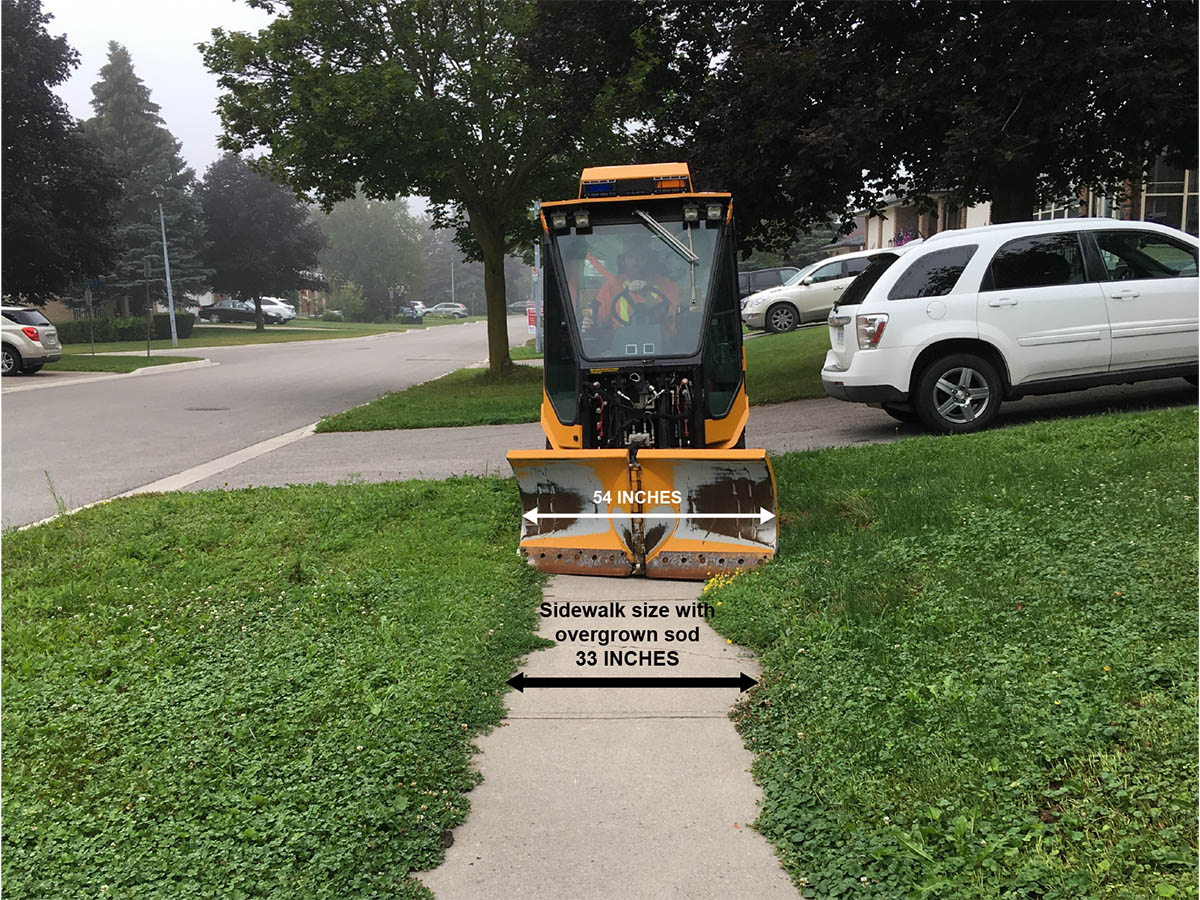
Why is there more damage done to my sod after a thaw/freeze cycle?
When the ground is wet due to the thawing of ice and snow, the sod does not have the opportunity to freeze fully. As a result more damage is done during sidewalk snow plowing operations. The root of the turf is intertwined with one another. When the plow blade catches an unfrozen lawn, it tends to tear a larger area than was initially struck. Unfortunately, as a result, even the slightest deviation of the plow from the sidewalk can leave significant damage.
How does overgrown sod affect sidewalk snow plowing?
Overgrown sod that isn’t edged can get caught on sidewalk snow plowing machines, causing damage to your lawn.
Sidewalk plows need to be the same size of the sidewalk in order to effectively clear as much snow as possible. If there is overgrown sod on the sidewalk, it can get caught onto the plow blade, causing damage to your sod.
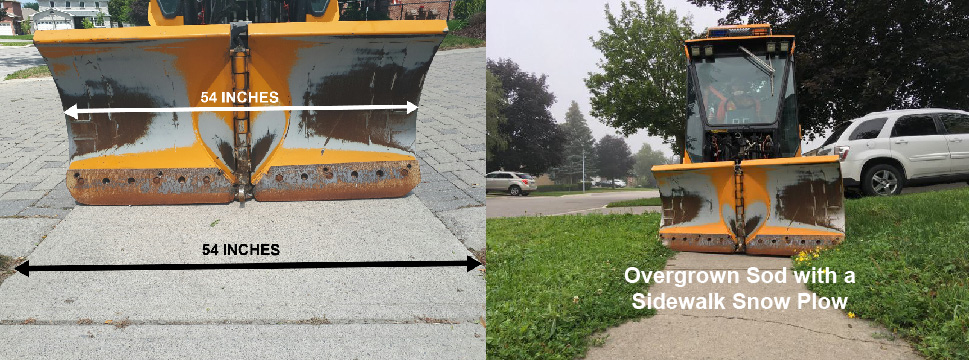
How do landscape features affect sidewalk snow plowing?
Landscape features such as driveway curbs, sprinkler heads, gardens or shrubs should be positioned at least 45 cm or 18 inches away from both sides of the sidewalk. This is to ensure that it does not interfere with the clearing of snow or present as a hazard to pedestrians.
Why do some streets see more damage from sidewalk snow plowing than others in the Town?
Not all sidewalks in the Town of Newmarket are the standard size of 1.5 m (59 inches) Older parts of Newmarket have sidewalks that are 1.2 m (48 inches) wide or less.
Many factors contribute to more damage during sidewalk snow plowing such as poor visibility for the operator, heavy snow falls and curved sidewalks. The Town continues to look for ways to minimize damage done to your property. This includes consulting various municipalities’ and industry manufacturers on different equipment and techniques that will minimize damage done to your property.
Why can’t the Town purchase smaller equipment for smaller sidewalks for my area?
The Town continues to consult industry manufacturers on smaller industrial grade sidewalk snow plows to minimize damage during sidewalk snow plowing operations.
The Town recently purchased a smaller piece of equipment to complete trial runs in the historical downtown area where the sidewalks are smaller in size. This piece of equipment helps clear sidewalks that are from 1.0 m (40 inches) to 1.2 m. (48 inches) The equipment does have issues with curb face sidewalks or heavy snow due to smaller horsepower and able to clear the snow. We are always working with leading industry manufacturers to find smaller industrial grade equipment.
This is a problem that all municipalities are facing and Town staff continue to look for ways to minimize the damage done to your property during sidewalks snow plowing operations.
In addition, smaller sidewalks will eventually be phased out due to AODA Legislation (Accessibility for Ontarians with Disabilities Act) that requires sidewalks to be constructed to standard size when the roadway is due for road re-construction. Due to the increase in size for standard sidewalks, coupled with the demand for smaller equipment, manufacturers are not producing any smaller equipment for sidewalk snow clearing at this time.
The Town continues to seek different ways to help minimize damage and improve our snow clearing procedures by consulting residents, neighbouring municipalities and industry leaders on best practices and procedures.
What has the Town done so far to minimize damage done to my sod/lawn?
The Town continues to consult neighbouring municipalities and industry leaders on best practices for sidewalk snow clearing. Some modifications/best practices include:
- Cutting the plow blade corners so that they become rounded. Doing so will minimize damage done to your sod if a small piece of sod gets caught on the blade.
- Angling the plow blade, as opposed to plowing straight so that the width of the blade is smaller when plowing smaller sidewalks.
- Plowing closer to the road on sidewalks that have no boulevard to minimize damage done to sod.
What can I do to help prevent damage to my sod and landscape features?
It is recommended that property owners edge their sod and ensure that all landscape features are not hanging over the sidewalk. Doing so will help prevent damage to their lawn/boulevard/landscape feature in the winter, when sidewalk snow plowing operations are in effect. The Town recommends that property owners follow these steps:
- Check and locate your property line and ensure nothing is placed on the Town’s road allowance
- Check to see if sod on your lawn has overgrown onto the sidewalk
- Edge any overgrown sod from the sidewalk back to the edge
- Check to see if your driveway curb/landscape feature is hanging over the sidewalk. If so, the recommended distance from the sidewalk is 18 inches as per MMS 239/02 16.2
Overgrown sod that isn't edged can get caught on sidewalk snow plowing machines, causing damage to your lawn. Landscape features that aren't set back from the sidewalk edge can also be damaged during sidewalk snow plowing operations. This is because the blades on sidewalk snow plowing machines need to be relatively close to the same size as the sidewalk surface in order to clear as much surface as possible and to effectively plow deep snow when required.
Ontario's MMS 239/02 states no encroachment of landscape features such as curbs, fences, shrubs, they are to be
set at least 18 inches back from the sidewalk edge. This distance creates a safety zone for pedestrians that may need to step off the sidewalk, as well as keeping the operator and your property safe.
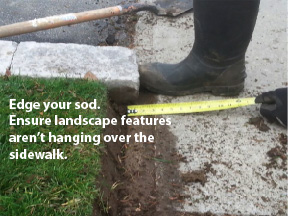
Where can I have landscape features and where can I not?
Residents are allowed to have landscape features anywhere within their property line. You can get a general idea of where your property line is by locating your water shut off valve located on your lawn. Landscape features are recommended to be at least 45 cm (18 inches) away from the sidewalk. If you currently have landscape features that reach the edge of your driveway, please shave the corner to at least 30 degrees to ensure it does not obstruct sidewalk snow clearing operations. The image below depicts landscape features that are too close to the sidewalk and will obstruct sidewalk snow plowing operations. 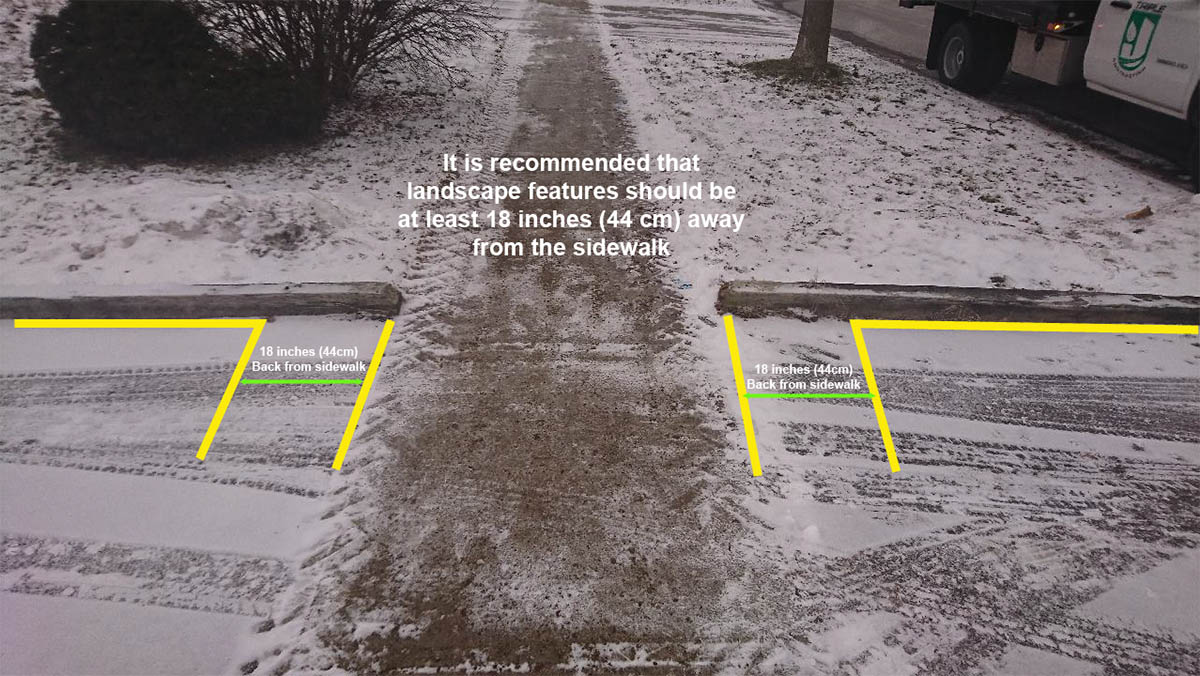
Sometimes sidewalks on major routes such as Davis Drive, Leslie Street, Bayview Avenue and Yonge Street look like they have not been plowed. Does the Town plow these streets?
Sidewalks on Davis Drive, Leslie Street, Bayview Avenue and Yonge Street are considered primary routes. This means that when sidewalk snow clearing operations begin, these sidewalks are cleared first because they lead to business areas, schools, bus routes and the hospital. Sometimes after Newmarket sidewalk snow crews have cleared these sidewalks, snow from the road, is plowed onto the sidewalk, by York Region snow plows. This causes the sidewalk to be full of snow again. See the photo below for an example:

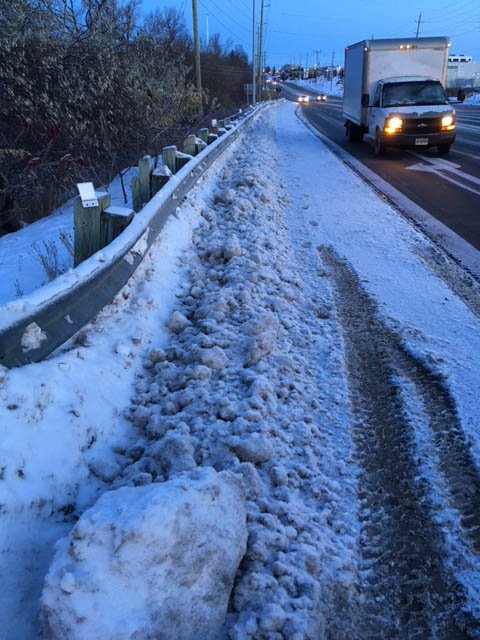
When this occurs, the Town makes a conscious effort to send crews back to these major sidewalk routes to clear them again. The Town is working with York Region to better align snow clearing schedules, but due to the unpredictability of inclement weather, it may be difficult sometimes to re-clear the snow right away.
Damaging the sod when plowing and then repairing it in the spring seems like a waste of money.
The Town understands that this may not seem like the most economical solution, but the Town is doing its best to minimize damage when conducting sidewalk snow clearing operations. The Town is committed and obligated to clear sidewalks in Newmarket for the safety of our residents and will continue to seek best practices to minimize damage to sod. You can help the cause by ensuring that your overgrown sod is edged and that landscape features are at least 18 inches (44 cm) away from the sidewalk.
The sidewalk snow plow is speeding down the sidewalk, who do I call?
All Town of Newmarket and contractor sidewalk snow plows are equipped with GPS tracking systems that monitor their speeds. The recommended speed for a sidewalk snow plow to effectively clear sidewalks is approximately 12 km/h. If you suspect that a sidewalk snow plowing is speeding, please call the Town of Newmarket at 905-895-5193.